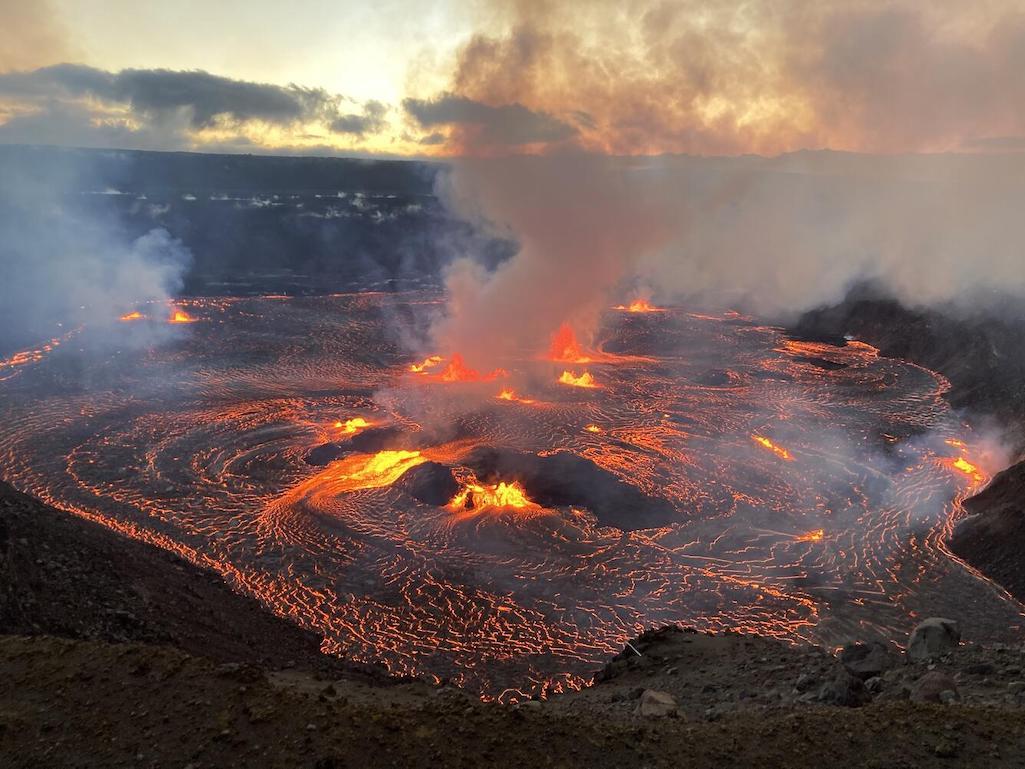
The most recent eruption at the summit of Kīlauea began on June 7, 2023, and lasted about two weeks. The current refilling phase at the summit, following the 2018 collapse, is part of a cycle of draining and refilling that has occurred many times in the past 200 years/USGS
Editor's note: Volcano Watch is a weekly article and activity update written by U.S. Geological Survey Hawaiian Volcano Observatory scientists and affiliates.
On August 1, 1823, an English missionary named William Ellis visited Kīlauea caldera with his Hawaiian guides on a tour of the Island of Hawaiʻi. He and his missionary companions were the first Westerners to visit the summit of Kīlauea, and the book that Ellis later published includes the first contemporary written observations of Kīlauea’s eruptive activity.
This summer marks 200 years since that visit, and now is a good time to highlight the past two centuries of written records of Kīlauea’s summit activity.
Of course, these writings follow the centuries of observations made by Native Hawaiians, reflected in rich oral traditions. Research in recent years has shown the close correspondence between the oral traditions and the geologic record.
The written descriptions began with Ellis and continued through the 1800s with sporadic visits by missionaries and others. In these early decades, the observers noted repeated episodes of subsidence of the caldera floor, sometimes related to rift zone eruptions. Titus Coan, a Hilo missionary, was a regular observer in this period and sent updates on Kīlauea’s activity to the American Journal of Science.
Volcano tourism was another factor that drew people to Kīlauea’s summit in the latter half of the 1800s. An important part of the written record is the Volcano House Register, a guestbook for the Volcano House hotel in which visitors could describe their stay. Their notes often had valuable descriptions of the active lava lake in Halemaʻumaʻu crater. Hawaiʻi Volcanoes National Park has a scanned version on their website.
One of the most vivid descriptions of Kīlauea’s summit lava lake comes from Mark Twain, who stayed at the Volcano House and made the trek across the caldera floor to Halemaʻumaʻu in 1866. He and his companions watched “a heaving sea of molten fire of seemingly limitless extent.”
Notable scientists also made occasional visits in the 1800s. James Dana, a famous American geologist, visited in 1840 with the U.S. Exploring Expedition, and again years later in the 1880s, writing the book “Characteristics of Volcanoes” based on these observations. An early U.S. Geological Survey geologist, Clarence Dutton, wrote a detailed report on Hawaiian volcanoes based on his expedition to the islands in the early 1880s.
Books including “The volcanoes of Kīlauea and Mauna Loa on the Island of Hawaii: their variously recorded history to the present time” (1909) and “Hawaii and its volcanoes” (1909) by American geologists William Brigham and Charles Hitchcock, respectively, provided detailed summaries of activity in Kīlauea caldera during the previous decades.
Regular, systematic reports on Kīlauea start with the arrival of Frank Perrett in 1911 and Thomas Jaggar in 1912, and the founding of the Hawaiian Volcano Observatory (HVO) at that time. The early observatory published monthly bulletins that included visual descriptions of the Halemaʻumaʻu lava lake, measurements of the constantly changing lava lake height, and notes on earthquake activity.
In the modern era, eruption documentation is done with many different written products. Current HVO updates on Kīlauea are generally daily to weekly, depending on activity levels. Reports in U.S. Geological Survey publications include detailed eruption chronologies, and papers in international science journals analyze the observations and data to try to understand the underlying processes.
A useful summary of Kīlauea’s activity and observations is in the book “Two hundred years of magma transport and storage at Kīlauea Volcano, Hawaiʻi, 1790-2008” written by Thomas Wright and Fred Klein. But things change quickly on Kīlauea, and there have already been numerous eruptive events since that book was published!
In addition to writings, the early observers of the 1800s and early 1900s also drew maps, made sketches and took photographs of Kīlauea’s summit activity, and some of these are featured in a paper by Ben Gaddis and Jim Kauahikaua, titled “Views of a century of activity at Kīlauea Caldera—A visual essay.” These visuals are another important source of documentation.
The British geologist Herbert Harold Read once said that the best geologist is the one who has “seen the most rocks.” In a similar vein, the best possible understanding of Kīlauea hinges on the most observations. Although no amount of writing can produce a complete picture of Kīlauea’s complex processes, 200 years is a respectable start.
Volcano Activity Updates
As of Friday, Kīlauea was not erupting. Its USGS Volcano Alert level is ADVISORY.
Active lava has not been visible within Halemaʻumaʻu crater at the summit of Kīlauea since June 19. Earthquake activity in the summit region has been low over the past week. Summit tiltmeters generally showed gradual inflation for much of the past week. A sulfur dioxide (SO2) emission rate of approximately 145 tonnes per day was measured on July 12.
Mauna Loa is not erupting. Its USGS Volcano Alert Level is at NORMAL.
Webcams show no signs of activity on Mauna Loa. Seismicity remains low. Summit ground deformation rates indicate slow inflation as magma replenishes the reservoir system following the recent eruption. SO2 emission rates are at background levels.
There was one earthquake with three or more felt reports in the Hawaiian Islands during the past week:a M3.8 earthquake 5 km (3 mi) SSW of Pāhala at 10 km (6 mi) depth on July 8 at 2:18 p.m. HST.
HVO continues to closely monitor Kīlauea and Mauna Loa.



Add comment